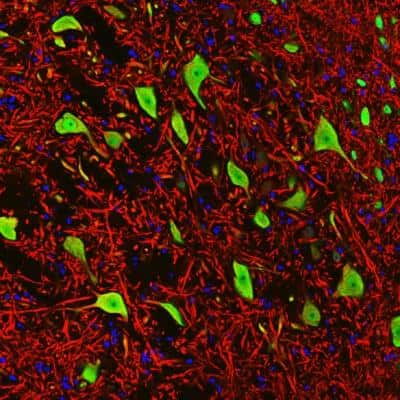RBFOX3/NeuN Products
Rbfox proteins participate in regulation of alternative splicing between family members as well as in autoregulation. While the breadth of brain and muscle specific targets for alternative splicing is well established for Rbfox proteins, those specific to Rbfox3/NeuN along with its alternative splicing mechanism are less understood. Rbfox3 has been shown to regulate neuronal differentiation by alternative splicing of Numb pre-mRNA and has a role in adult neurogenesis. Dysfunctional Rbfox3/NeuN has been associated with various neurological disorders such as neurodevelopmental delay, autism spectrum disorder, Benign rolandic epilepsy (BRE), and cognitive impairments (1,2).
References
1. Duan W, Zhang YP, Hou Z, Huang C, Zhu H, Zhang CQ, Yin Q. (2016) Novel Insights into NeuN: from Neuronal Marker to Splicing Regulator. Mol Neurobiol. 53(3):1637-1647. PMID: 25680637.
2. Su CH, D D, Tarn WY. (2018) Alternative Splicing in Neurogenesis and Brain Development. Front Mol Biosci. 5:12. PMID: 29484299
401 results for "RBFOX3/NeuN" in Products
401 results for "RBFOX3/NeuN" in Products
RBFOX3/NeuN Products
Rbfox proteins participate in regulation of alternative splicing between family members as well as in autoregulation. While the breadth of brain and muscle specific targets for alternative splicing is well established for Rbfox proteins, those specific to Rbfox3/NeuN along with its alternative splicing mechanism are less understood. Rbfox3 has been shown to regulate neuronal differentiation by alternative splicing of Numb pre-mRNA and has a role in adult neurogenesis. Dysfunctional Rbfox3/NeuN has been associated with various neurological disorders such as neurodevelopmental delay, autism spectrum disorder, Benign rolandic epilepsy (BRE), and cognitive impairments (1,2).
References
1. Duan W, Zhang YP, Hou Z, Huang C, Zhu H, Zhang CQ, Yin Q. (2016) Novel Insights into NeuN: from Neuronal Marker to Splicing Regulator. Mol Neurobiol. 53(3):1637-1647. PMID: 25680637.
2. Su CH, D D, Tarn WY. (2018) Alternative Splicing in Neurogenesis and Brain Development. Front Mol Biosci. 5:12. PMID: 29484299
| Reactivity: | Human, Mouse, Rat |
| Details: | Mouse IgG2b Kappa Monoclonal Clone #1B7 |
| Applications: | IHC, WB, ICC/IF, Flow, CyTOF-ready, +1 More |
| Reactivity: | Human, Mouse, Rat, Bovine, Porcine |
| Details: | Rabbit IgG Polyclonal |
| Applications: | IHC, WB, ICC/IF, Flow |
Recombinant Monoclonal Antibody
| Reactivity: | Human, Mouse |
| Details: | Rabbit IgG Kappa Monoclonal Clone #NeuN/288R |
| Applications: | IHC, WB |
| Reactivity: | Human |
| Details: | Mouse IgG2b Kappa Monoclonal Clone #NEUN/7167 |
| Applications: | IHC |
Recombinant Monoclonal Antibody
| Reactivity: | Human |
| Details: | Rabbit IgG Kappa Monoclonal Clone #NeuN/6694R |
| Applications: | IHC |
Recombinant Monoclonal Antibody
| Reactivity: | Human |
| Details: | Mouse IgG1 kappa Monoclonal Clone #rNEUN/8054 |
| Applications: | IHC |
Recombinant Monoclonal Antibody
| Reactivity: | Human |
| Details: | Mouse IgG1 kappa Monoclonal Clone #rNEUN/8055 |
| Applications: | IHC |
| Reactivity: | Human |
| Details: | Mouse IgG2b Kappa Monoclonal Clone #NEUN/7168 |
| Applications: | IHC |
Recombinant Monoclonal Antibody
| Reactivity: | Human |
| Details: | Rabbit IgG Kappa Monoclonal Clone #NEUN/8096R |
| Applications: | IHC |
Recombinant Monoclonal Antibody
| Reactivity: | Human |
| Details: | Rabbit IgG Kappa Monoclonal Clone #NEUN/8096R |
| Applications: | IHC |
Recombinant Monoclonal Antibody
| Reactivity: | Human |
| Details: | Mouse IgG1 kappa Monoclonal Clone #rNEUN/8054 |
| Applications: | IHC |
Recombinant Monoclonal Antibody
| Reactivity: | Human |
| Details: | Mouse IgG1 kappa Monoclonal Clone #rNEUN/8055 |
| Applications: | IHC |
Recombinant Monoclonal Antibody
| Reactivity: | Human, Mouse |
| Details: | Rabbit IgG Kappa Monoclonal Clone #NeuN/288R |
| Applications: | IHC |
Recombinant Monoclonal Antibody
| Reactivity: | Human |
| Details: | Rabbit IgG Kappa Monoclonal Clone #NeuN/6694R |
| Applications: | IHC |
Recombinant Monoclonal Antibody
| Reactivity: | Human |
| Details: | Mouse IgG1 kappa Monoclonal Clone #rNEUN/8054 |
| Applications: | IHC |
| Reactivity: | Human |
| Details: | Mouse IgG2b Kappa Monoclonal Clone #NEUN/7167 |
| Applications: | IHC |
| Reactivity: | Human |
| Details: | Mouse IgG2b Kappa Monoclonal Clone #NEUN/7168 |
| Applications: | IHC |
| Reactivity: | Human |
| Details: | Mouse IgG2b Kappa Monoclonal Clone #NEUN/7168 |
| Applications: | IHC |
Recombinant Monoclonal Antibody
| Reactivity: | Human, Mouse |
| Details: | Rabbit IgG Kappa Monoclonal Clone #NeuN/288R |
| Applications: | IHC |
| Reactivity: | Human |
| Details: | Mouse IgG2b Kappa Monoclonal Clone #NEUN/7168 |
| Applications: | IHC |
Recombinant Monoclonal Antibody
| Reactivity: | Human |
| Details: | Mouse IgG1 kappa Monoclonal Clone #rNEUN/8054 |
| Applications: | IHC |
Recombinant Monoclonal Antibody
| Reactivity: | Human |
| Details: | Rabbit IgG Kappa Monoclonal Clone #NEUN/8096R |
| Applications: | IHC |
Recombinant Monoclonal Antibody
| Reactivity: | Human |
| Details: | Rabbit IgG Kappa Monoclonal Clone #NeuN/6694R |
| Applications: | IHC |
Recombinant Monoclonal Antibody
| Reactivity: | Human |
| Details: | Rabbit IgG Kappa Monoclonal Clone #NeuN/6694R |
| Applications: | IHC |
Recombinant Monoclonal Antibody
| Reactivity: | Human, Mouse |
| Details: | Rabbit IgG Kappa Monoclonal Clone #NeuN/288R |
| Applications: | IHC |


![Immunohistochemistry-Paraffin: RBFOX3/NeuN Antibody - BSA Free [NBP1-77686] Immunohistochemistry-Paraffin: RBFOX3/NeuN Antibody - BSA Free [NBP1-77686]](https://resources.bio-techne.com/images/products/RBFOX3-NeuN-Antibody-Immunohistochemistry-Paraffin-NBP1-77686-img0007.jpg)
![Western Blot: RBFOX3/NeuN Antibody (NeuN/288R) [NBP3-13857] Western Blot: RBFOX3/NeuN Antibody (NeuN/288R) [NBP3-13857]](https://resources.bio-techne.com/images/products/RBFOX3-NeuN-Antibody-NeuN-288R-Western-Blot-NBP3-13857-img0002.jpg)

![Immunohistochemistry-Paraffin: RBFOX3/NeuN Antibody (NeuN/6694R) [NBP3-13858] Immunohistochemistry-Paraffin: RBFOX3/NeuN Antibody (NeuN/6694R) [NBP3-13858]](https://resources.bio-techne.com/images/products/RBFOX3-NeuN-Antibody-NeuN-6694R-Immunohistochemistry-Paraffin-NBP3-13858-img0002.jpg)
![Immunohistochemistry-Paraffin: RBFOX3/NeuN Antibody (rNEUN/8054) [NBP3-23684] - RBFOX3/NeuN Antibody (rNEUN/8054) Immunohistochemistry-Paraffin: RBFOX3/NeuN Antibody (rNEUN/8054) [NBP3-23684] -](https://resources.bio-techne.com/images/products/nbp3-23684_mouse-rbfox3-neun-mab-rneun-8054-2412025872390.jpg)
![Immunohistochemistry-Paraffin: RBFOX3/NeuN Antibody (rNEUN/8055) [NBP3-23673] - RBFOX3/NeuN Antibody (rNEUN/8055) Immunohistochemistry-Paraffin: RBFOX3/NeuN Antibody (rNEUN/8055) [NBP3-23673] -](https://resources.bio-techne.com/images/products/nbp3-23673_mouse-rbfox3-neun-mab-rneun-8055-2412025863691.jpg)

![Immunohistochemistry-Paraffin: RBFOX3/NeuN Antibody (NEUN/8096R) [NBP3-23685] - RBFOX3/NeuN Antibody (NEUN/8096R) Immunohistochemistry-Paraffin: RBFOX3/NeuN Antibody (NEUN/8096R) [NBP3-23685] -](https://resources.bio-techne.com/images/products/nbp3-23685_rabbit-rbfox3-neun-mab-neun-8096r-2412025872325.jpg)
